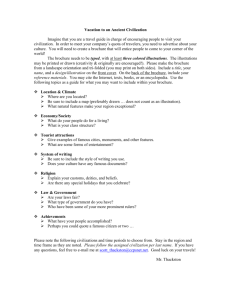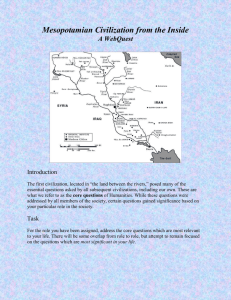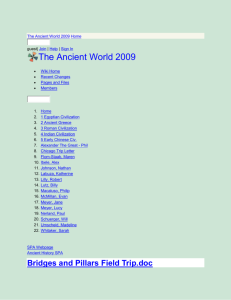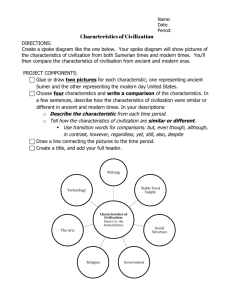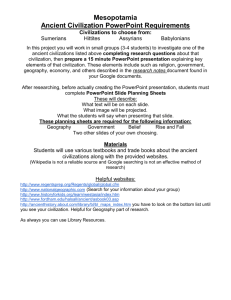Agricultural Revolutions to River Valleys
advertisement
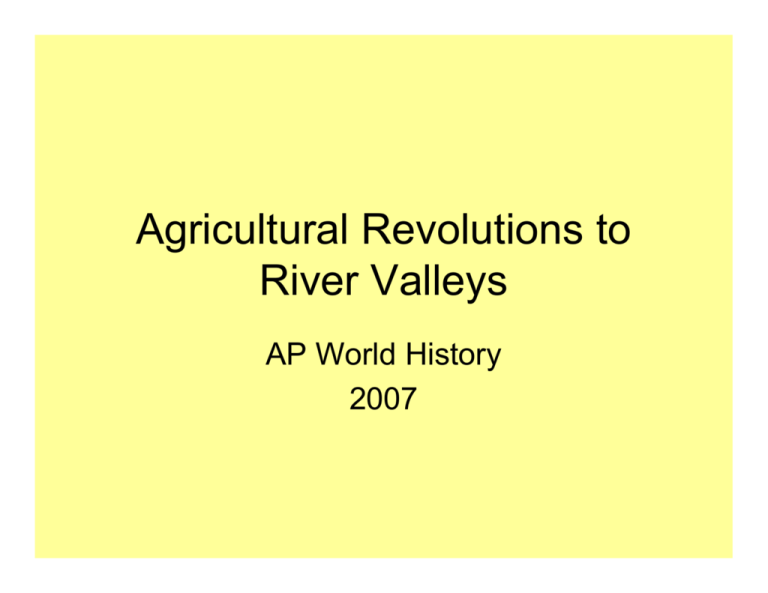
Agricultural Revolutions to River Valleys AP World History 2007 Pre-Civilization • Farmers needed stability to control water Small groups could not regulate waters Small groups could not defend area • Small, self-sufficient farming villages form First appeared in SW Asia around 6000 BCE Catal Huyuk in Turkey as example Evidence of trade, tool making, artisans Evidence of complex religion Specialization of occupations: politics, military Evidence of metal working (Bronze Age) Introduction to Civilization • Definition of civilization A form of culture represented by complex institutions, specialized workers, cities, recordkeeping, and advanced technology Introduction to Civilization Development of civilizations Culture hearths Mesopotamia—3500 BCE Egypt—3100 BCE Indus River Valley—2500 BCE Ancient China—2000 BCE Mesoamerica—1250 BCE What environmental conditions were needed to develop the first civilizations? Ancient Mesopotamia • Farming develops in the Fertile Crescent by 4500 BCE Fertile soil caused by flooding rivers was good for farming • Three Disadvantages Flooding of rivers was unpredictable No natural barriers for protection Natural resources were limited • “Necessity is the mother of invention” Ancient Mesopotamia • Sumer first civilization c. 3500 BCE Initially priests ruled citystates Built large temples called ziggurats Eventually kings took over power Power passed to sons creating dynasties Land owning aristocracy dominated Ancient Mesopotamia • Sumerian Religion Believed in 3,000 gods Religion was to appease gods, control nature Art and literature focus on gods and religion Epic of Gilgamesh • Sumerian Society Clearly defined social classes Slavery was common Women could hold most occupations Ancient Mesopotamia • Sumerian Economy Majority of people farmed Traded for needed resources along the Nile-Indus Corridor • Sumerian Science and Technology Inventions: wheel, sail, and plow 1st to use bronze 1st system of writing— cuneiform 1st number system Later Mesopotamians • Cycle of Civilization Nomads conquer sedentary people Conquerors assimilate local culture New civilization blends cultures & thrives “New” civilization grows old and is invaded • Akkad “First” First Empire—conquered all of Sumer • Babylonian “First” Hammurabi’s Code—1st written code of law Ancient Egypt • Geography different from Sumer Relatively isolated Nile flooded regularly, predictably Provided rich soil,easy soil to farm Civilization regulated flooding, surveying Ancient Egypt • Egyptian Government Unified for most of history Theocracy Pharaoh was a god-king Built pyramid tombs for dead • Egyptian Religion Thousands of gods Relatively egalitarian Believe in afterlife Mummification Ancient Egypt • Egyptian Society Clearly defined social classes Social mobility was possible Slavery was a widespread source of labor Women had more rights than other societies Could own property, propose marriage, demand a divorce Women could be pharaohs Ancient Egypt • Cultural Achievements Hieroglyphic writing system Papyrus Mathematics helped engineers and farmers An early form of geometry Calendar system 365 days (off by 6 hours) Medicine Indus River Valley • City-states of Harappa and Mohenjo-Daro emerged around 2500 BCE Extremely well-planned, coordinated cities with temples at the center Polytheistic religion Undecipherable writing system Advanced technology Plumbing systems • Mysterious ending Environmental degradation vs. Aryan invasion Ancient China • Developed in isolation along the Huang He (Yellow) River around 2000 BCE Xia Dynasty (mythical?) • Shang Dynasty emerged around 1500 BCE Warlike kings & landed aristocracy dominate Few priests Cities surrounded by massive earthen walls Most people worked land as peasants Ancient China • Chinese Society Family was center of society Men dominant; women were subordinate • Chinese Culture Believed spirits of family ancestors could bring good fortune or disaster Chinese writing Oracle bones Helped unify a large, diverse land Technology: bronze working and silk Mandate of Heaven • Mandate of Heaven Rulers are chose to rule by heaven and will continue to rule as long as heaven is pleased If heaven is not pleased, heaven will take back mandate to rule and pass the mandate to another family • Common Indicators of a Lost Mandate Wars, invasions, military disasters Over-taxation, disgruntled peasants, crime Moral decline of elite classes Legacy of Ancient Civilizations • Major characteristics passed on Writing systems inherited Religious, philosophical systems copied Useful inventions rarely forgotten, easily spread • Ancient civilizations decline by 1000 BCE All subject to nomadic invasions Indo-Europeans and Semites were strongest Geographical centers shifted (all except China) Civilization Spreads • Phoenician Sailors in Lebanon City-states traded across Mediterranean Invented alphabet • Lydians, Hittites in Asia Minor Introduced Iron, coinage to area • Hebrews in Palestine Large Semitic migration in area Ethical monotheism Conduct determines salvation Acknowledgement • The text of this power point was taken from Mr. Jeremy Millhouse’s AP World History website. http://tweb.lisd.net/jeremy_millhouse/index .htm • Pictures were culled from the internet and credits follow on the next two slides. Picture Credits • http://www.harpercollege.edu/mhealy/geog res/maps/worldgif/wwhearth.gif • http://www.utexas.edu/courses/classicalar ch/images2/mapane.jpg • http://www.crystalinks.com/ziggurat4.jpg • http://cache.eb.com/eb/image?id=84493&r endTypeId=4 • http://www.artsci.wustl.edu/~anthro/course s/306/Nile%20Delta.jpg Picture Credits Continued • http://www.ebibleteacher.com/images/pyramid.jpg • http://www.egypt-tehuti.org/photo-gallery/steppyramid.jpg • http://www.historyforkids.org/learn/india/literature/picture s/harappa2.jpg • http://www.lib.cuhk.edu.hk/uclib/bones/ob01.gif • http://www.mcps.k12.md.us/departments/isa/ninvest/min g/gr/Dynastic%20cycle%20info003.gif • http://www.georgehernandez.com/h/About/media/Phoeni cian_gimel.png • http://rg.ancients.info/lion/Lydian_trite_o.jpg • http://www.imninalu.net/2history_file/MiddleEast2.gif



